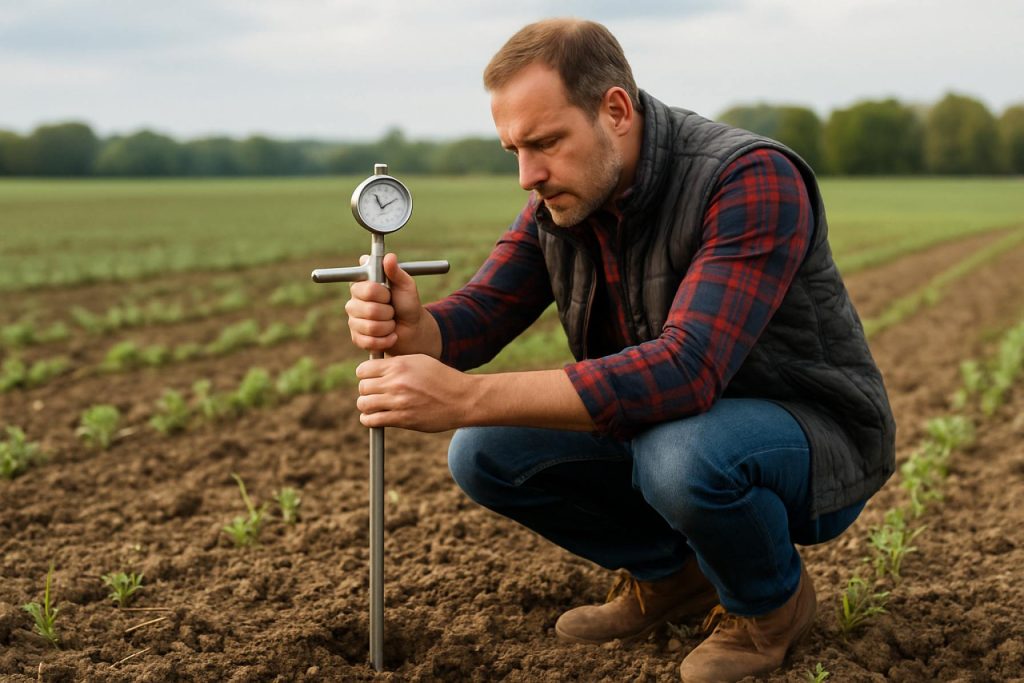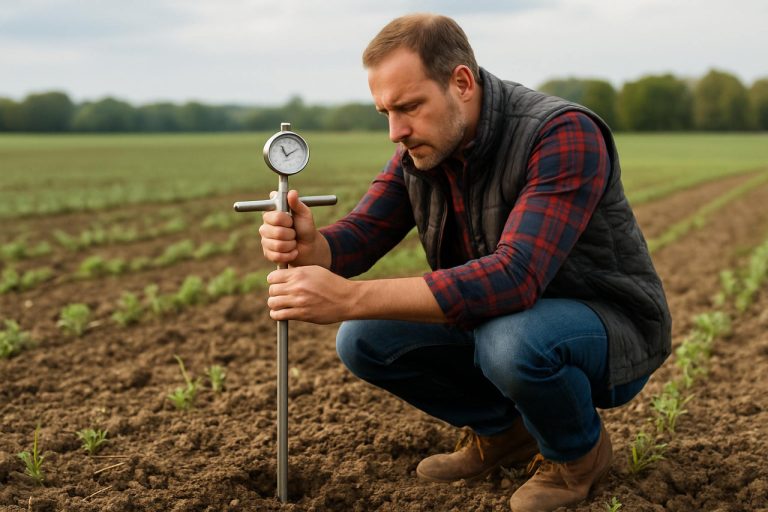
Penetrometer Soil Testing Demystified: How Cutting-Edge Techniques Transform Soil Analysis and Boost Project Success
- Introduction to Penetrometer Soil Testing
- How Penetrometers Work: Principles and Technology
- Types of Penetrometers and Their Applications
- Step-by-Step Guide to Conducting Penetrometer Tests
- Interpreting Penetrometer Data: What the Results Mean
- Benefits of Penetrometer Testing in Construction and Agriculture
- Limitations and Considerations in Penetrometer Soil Testing
- Recent Innovations and Future Trends in Penetrometer Technology
- Best Practices for Accurate and Reliable Soil Testing
- Conclusion: Maximizing Value from Penetrometer Soil Testing
- Sources & References
Introduction to Penetrometer Soil Testing
Penetrometer soil testing is a widely used method for assessing soil compaction, strength, and consistency in agricultural, geotechnical, and environmental applications. The technique involves inserting a penetrometer—a device equipped with a standardized cone or probe—into the soil and measuring the resistance encountered. This resistance provides valuable data on soil properties such as density, bearing capacity, and the presence of compacted layers that may impede root growth or water infiltration. Penetrometer readings are typically expressed in terms of force per unit area (e.g., kPa or psi), allowing for quantitative comparisons across different sites and soil types.
The importance of penetrometer soil testing lies in its ability to offer rapid, in-situ assessments of soil conditions, which are critical for informed decision-making in construction, agriculture, and land management. For example, in agriculture, excessive soil compaction detected by penetrometer testing can signal the need for tillage or other remediation to improve crop yields. In civil engineering, penetrometer data help determine the suitability of soil for supporting structures and inform foundation design. The method is valued for its simplicity, portability, and cost-effectiveness compared to more elaborate laboratory-based soil tests.
Standardized procedures for penetrometer testing are outlined by organizations such as the ASTM International and the International Organization for Standardization (ISO), ensuring consistency and reliability of results. As technology advances, digital penetrometers and data logging systems are further enhancing the accuracy and efficiency of soil resistance measurements, making penetrometer soil testing an indispensable tool in modern soil science and engineering.
How Penetrometers Work: Principles and Technology
Penetrometers are specialized instruments designed to assess soil strength and compaction by measuring the resistance of soil to penetration. The core principle behind penetrometer soil testing is the quantification of the force required to insert a probe or cone into the ground at a controlled rate. This resistance is directly related to soil properties such as density, moisture content, and texture, which are critical for applications in agriculture, geotechnical engineering, and environmental studies.
There are two main types of penetrometers: static and dynamic. Static penetrometers, such as the cone penetrometer, are pushed into the soil at a constant rate, and the resistance is measured continuously or at set intervals. Dynamic penetrometers, on the other hand, use a weight dropped from a specific height to drive the probe into the soil, with the number of blows required to reach a certain depth serving as the measurement. Both types provide valuable data on soil compaction and bearing capacity.
Modern penetrometers often incorporate digital sensors and data loggers, enabling real-time data collection and analysis. Some advanced models are equipped with GPS for precise location tracking and can measure additional parameters such as soil moisture and electrical conductivity. The data collected can be used to create detailed soil compaction maps, which are essential for optimizing agricultural practices and ensuring the stability of construction projects. For more information on penetrometer technology and its applications, refer to resources from the ASTM International and the United States Department of Agriculture.
Types of Penetrometers and Their Applications
Penetrometer soil testing employs a variety of instruments, each tailored to specific soil conditions and testing requirements. The most common types include the cone penetrometer, pocket penetrometer, dynamic penetrometer, and static penetrometer. The ASTM International standardizes many of these devices, ensuring consistency in soil strength measurements.
The cone penetrometer is widely used for geotechnical investigations, particularly in the Cone Penetration Test (CPT). It measures soil resistance as a cone-tipped probe is pushed into the ground at a constant rate, providing continuous profiles of soil stratigraphy and mechanical properties. This method is especially valuable for identifying soil layers and assessing bearing capacity for construction projects (U.S. Geological Survey).
The pocket penetrometer is a handheld device primarily used for quick, on-site estimation of the unconfined compressive strength of cohesive soils, such as clays. It is commonly utilized in field assessments for slope stability and trench safety (Occupational Safety and Health Administration).
Dynamic penetrometers, such as the Dynamic Cone Penetrometer (DCP), involve driving a cone into the soil using repeated blows from a standardized weight. This method is effective for evaluating the compaction and strength of granular soils, making it useful in road construction and pavement design (Federal Highway Administration).
Static penetrometers are similar to cone penetrometers but rely on steady, controlled pressure rather than dynamic force. They are often used in laboratory settings or for sensitive soils where dynamic methods may cause disturbance.
Selecting the appropriate penetrometer depends on soil type, project requirements, and the desired data resolution, ensuring accurate and reliable soil characterization for engineering and environmental applications.
Step-by-Step Guide to Conducting Penetrometer Tests
Conducting penetrometer soil tests involves a systematic approach to ensure accurate and reliable results. The following step-by-step guide outlines the essential procedures:
- Site Preparation: Clear the test area of debris, vegetation, and loose material. Ensure the soil surface is as level as possible to avoid skewed readings.
- Equipment Calibration: Before testing, calibrate the penetrometer according to the manufacturer’s instructions. This step is crucial for both mechanical and digital devices to maintain measurement accuracy (ASTM International).
- Test Execution: Position the penetrometer vertically on the soil surface. Apply a steady, uniform force to push the probe into the soil at a constant rate, typically around 2 cm/sec. Record the resistance or penetration depth at regular intervals, as specified by the test protocol (International Organization for Standardization).
- Data Recording: Document the penetration resistance readings at each depth increment. For digital penetrometers, download and store the data electronically. For manual devices, use standardized forms for consistency.
- Multiple Measurements: Conduct several tests at different locations within the site to account for soil variability. This helps in obtaining a representative assessment of soil strength and compaction.
- Post-Test Procedures: Clean the penetrometer thoroughly after use to prevent cross-contamination between sites. Review and analyze the collected data to interpret soil conditions.
Following these steps ensures that penetrometer soil testing yields reliable data for applications in agriculture, construction, and geotechnical investigations (Food and Agriculture Organization of the United Nations).
Interpreting Penetrometer Data: What the Results Mean
Interpreting penetrometer data is crucial for understanding soil compaction, strength, and suitability for various agricultural or engineering applications. The primary output from a penetrometer test is the penetration resistance, typically measured in megapascals (MPa) or pounds per square inch (psi), as the device is pushed into the soil. High resistance values often indicate compacted layers, which can restrict root growth, water infiltration, and gas exchange. Conversely, low resistance suggests loose or well-structured soil, generally favorable for plant development and drainage.
A common threshold for root-limiting compaction is around 2 MPa; values above this may impede root penetration for many crops. However, interpretation must consider soil moisture, texture, and organic matter, as these factors significantly influence resistance readings. For instance, dry soils tend to show higher resistance, while wet soils may yield artificially low values. Therefore, it is recommended to conduct tests at field capacity moisture for consistency and comparability.
Penetrometer data are often plotted as resistance versus depth profiles, revealing compacted layers (hardpans) or changes in soil structure. Identifying these layers helps inform management decisions, such as the need for subsoiling or adjusting tillage practices. Additionally, repeated measurements over time can track the effectiveness of soil management interventions.
For accurate interpretation, it is essential to calibrate the penetrometer and follow standardized procedures, as outlined by organizations like the USDA Natural Resources Conservation Service and the ASTM International. These guidelines ensure reliable, reproducible results that can be meaningfully compared across sites and seasons.
Benefits of Penetrometer Testing in Construction and Agriculture
Penetrometer soil testing offers significant advantages in both construction and agriculture by providing rapid, in-situ assessments of soil strength and compaction. In construction, penetrometer data is crucial for evaluating the bearing capacity of soils, which directly influences foundation design and the selection of appropriate construction techniques. By identifying weak or overly compacted layers, engineers can mitigate risks of settlement or structural failure, ensuring safer and more cost-effective projects. The use of penetrometers also streamlines site investigations, reducing the need for extensive laboratory testing and expediting project timelines ASTM International.
In agriculture, penetrometer testing is instrumental in diagnosing soil compaction, a common issue that restricts root growth and reduces crop yields. By measuring the resistance of soil to penetration, farmers and agronomists can pinpoint compacted zones and make informed decisions about tillage, irrigation, and crop rotation. This targeted approach helps optimize soil structure, improve water infiltration, and enhance nutrient availability, ultimately leading to healthier crops and increased productivity USDA Natural Resources Conservation Service.
Furthermore, penetrometer testing is valued for its portability, ease of use, and ability to provide immediate results in the field. This makes it a practical tool for ongoing soil monitoring and adaptive management in both sectors. Overall, the integration of penetrometer testing into construction and agricultural practices supports sustainable land use and resource management Food and Agriculture Organization of the United Nations.
Limitations and Considerations in Penetrometer Soil Testing
While penetrometer soil testing is a widely used method for assessing soil compaction and strength, several limitations and considerations must be acknowledged to ensure accurate interpretation of results. One primary limitation is the influence of soil moisture content; penetrometer readings can vary significantly depending on whether the soil is wet or dry, potentially leading to inconsistent data if moisture conditions are not standardized during testing. Additionally, soil texture and structure—such as the presence of gravel, roots, or organic matter—can affect penetration resistance, sometimes resulting in misleadingly high or low readings that do not accurately reflect true compaction levels.
Another consideration is the depth of measurement. Handheld penetrometers typically provide data only for the upper soil layers, which may not represent deeper compaction zones critical for root development and water infiltration. Furthermore, operator technique, including the speed and angle of insertion, can introduce variability in results, underscoring the need for standardized procedures and proper training. Calibration of the device is also essential, as different penetrometer models may yield varying results under identical conditions.
Finally, penetrometer data should be interpreted in conjunction with other soil assessments, such as bulk density measurements and visual soil structure evaluations, to provide a comprehensive understanding of soil health. Recognizing these limitations and considerations is crucial for making informed management decisions based on penetrometer soil testing results (USDA Natural Resources Conservation Service, Food and Agriculture Organization of the United Nations).
Recent Innovations and Future Trends in Penetrometer Technology
Recent years have witnessed significant advancements in penetrometer soil testing, driven by the need for more precise, efficient, and data-rich soil assessments. One notable innovation is the integration of digital sensors and wireless data transmission, allowing real-time collection and analysis of penetration resistance data. Modern penetrometers now often feature GPS connectivity, enabling the georeferencing of soil strength measurements for spatial mapping and precision agriculture applications. These developments facilitate the creation of detailed soil compaction maps, which are invaluable for optimizing tillage and crop management strategies (U.S. Department of Agriculture).
Another emerging trend is the use of automated and robotic penetrometer systems. These platforms can perform high-density sampling across large fields with minimal human intervention, increasing both the speed and consistency of data collection. Additionally, advances in sensor technology have enabled the measurement of multiple soil parameters—such as moisture content, electrical conductivity, and temperature—simultaneously with penetration resistance, providing a more comprehensive understanding of soil conditions (Elsevier).
Looking ahead, the integration of artificial intelligence and machine learning algorithms is expected to further enhance the interpretation of penetrometer data, enabling predictive modeling of soil behavior under various management scenarios. The continued miniaturization and cost reduction of sensors may also make advanced penetrometer technology more accessible to small-scale farmers and researchers worldwide (Food and Agriculture Organization of the United Nations).
Best Practices for Accurate and Reliable Soil Testing
Achieving accurate and reliable results in penetrometer soil testing requires adherence to several best practices throughout the sampling and measurement process. First, it is essential to ensure that the penetrometer is properly calibrated before each use, as calibration errors can significantly affect readings. Operators should use consistent insertion rates—typically around 2 cm per second—to minimize variability caused by speed, as recommended by the USDA Natural Resources Conservation Service. The soil moisture content at the time of testing should be noted, since soil strength readings can vary dramatically between wet and dry conditions. Ideally, tests should be conducted when the soil is at field capacity to provide representative data.
Site selection and preparation are also critical. Avoid areas with recent disturbances, such as tillage or heavy traffic, and clear the surface of debris and vegetation to prevent interference with the probe. Multiple measurements should be taken across the test area to account for spatial variability, and results should be averaged or mapped to identify compaction patterns. The Food and Agriculture Organization of the United Nations recommends recording the depth at which resistance increases sharply, as this often indicates a compacted layer or hardpan.
Finally, all data—including environmental conditions, soil type, and operator details—should be meticulously documented to ensure repeatability and facilitate comparison with future tests. Following these best practices enhances the reliability of penetrometer soil testing and supports informed soil management decisions.
Conclusion: Maximizing Value from Penetrometer Soil Testing
Maximizing the value of penetrometer soil testing hinges on integrating its results into a broader soil management strategy. While penetrometers provide rapid, in-situ measurements of soil compaction and resistance, their true utility emerges when data is interpreted alongside other agronomic indicators such as soil moisture, organic matter content, and crop performance. Regular testing across different field locations and seasons enables the identification of compaction trends, guiding targeted interventions like subsoiling, controlled traffic farming, or cover cropping to alleviate problem areas. Moreover, advances in digital penetrometers and data logging facilitate the creation of detailed soil compaction maps, supporting precision agriculture practices and optimizing resource allocation.
To ensure reliable results, it is essential to standardize testing protocols—such as maintaining consistent insertion speed and soil moisture conditions—thereby minimizing variability and enhancing comparability over time. Training personnel in proper use and interpretation further increases the reliability of findings. Collaborating with agronomists or soil scientists can help translate penetrometer readings into actionable recommendations tailored to specific crops and soil types. Ultimately, by leveraging penetrometer data as part of an integrated soil health assessment, farmers and land managers can make informed decisions that improve crop yields, reduce input costs, and promote long-term soil sustainability. For further guidance on best practices and interpretation, resources from organizations like the USDA Natural Resources Conservation Service and Food and Agriculture Organization of the United Nations are invaluable.
Sources & References
- ASTM International
- International Organization for Standardization (ISO)
- Federal Highway Administration
- Food and Agriculture Organization of the United Nations
- U.S. Department of Agriculture



